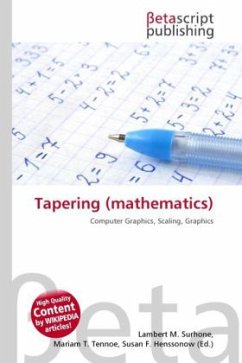
Tapering (mathematics)
Versandkostenfrei!
Versandfertig in 6-10 Tagen
26,99 €
inkl. MwSt.

PAYBACK Punkte
13 °P sammeln!
High Quality Content by WIKIPEDIA articles! In mathematics, physics, and theoretical computer graphics, tapering is a kind of shape deformation. Just as an affine transformation, such as scaling or shearing, is a first-order model of shape deformation, there also exist higher-order deformations such as tapering, twisting, and bending. Tapering can be thought of as non-constant scaling by a given tapering function. The resultant deformations can be linear or nonlinear. As another example, if the parametric equation of a cube were given by (t) = (x(t), y(t), z(t)), a nonlinear taper could be app...
High Quality Content by WIKIPEDIA articles! In mathematics, physics, and theoretical computer graphics, tapering is a kind of shape deformation. Just as an affine transformation, such as scaling or shearing, is a first-order model of shape deformation, there also exist higher-order deformations such as tapering, twisting, and bending. Tapering can be thought of as non-constant scaling by a given tapering function. The resultant deformations can be linear or nonlinear. As another example, if the parametric equation of a cube were given by (t) = (x(t), y(t), z(t)), a nonlinear taper could be applied so that the cube's volume slowly decreases (or tapers) as the function moves in the positive z direction. For the given cube, an example of a nonlinear taper along z would be if, for instance, the function T(z) = 1/(a + bt) were applied to the cube's equation such that (t) = (T(z)x(t), T(z)y(t), T(z)z(t)), for some real constants a and b.












